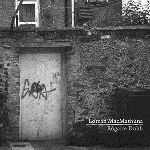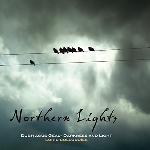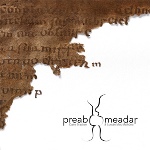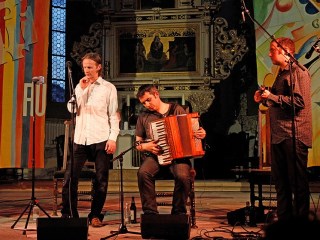





Lorcán Mac Mathúna wraps Sean-nós, the ancient art of unaccompanied traditional Irish singing with its Gaelic lyrics, richly ornamented melodies and a rather harsh vocal approach, in new clothes. Tom Keller took the opportunity to explore Lorcán 's musical vision.
Walkin' Tom Keller: To put it simple, you are a representative of Sean-nós, the ancient art of unaccompanied traditional Irish singing. How did you come to this type of music?
Lorcán Mac Mathúna: Traditional music is part of my family heritage. My father came from a traditional music heartland in Co. Clare and was centrally involved in the whole revival of Irish music from the 1950’s onwards. It was during that explosive period of resurgence, and reaching out to other traditional communities, that he encountered Sean-Nós, and he became completely hooked. My mother was singing since she was very young and some years down the line they met. Suffice to say Sean-Nós singing was just part of my home environment from early childhood and I absorbed it all; like breathing air.
Which influences and inspirations did you get then all along your musical progress?
Lorcán: Ahh… this always changes as you grow and experiment, and develop collaborations, and compose, and listen. I am never done listening and don’t think I ever will be. I am musically curious, and will prod and poke at technique, so I love vocal music, from polyphonies to a bulleria and everything in between. I love listening to the tones of Scandinavian music; and the rhythms of Congolese music fascinate me; and I could listen to Corsican polyphonies for hours in complete stillness, they just have a lonely beauty which seems completely indulgent; and the thick tones and harmonics of Tuvan overtones; or an orchestrated classical piece like Mozart’s Requiem.
Mostly I like music with depth and rich tones and colour, but I have to say that I like music which has roots and a history best, because this determines how to interpret it. From the purely Sean-Nós tradition I loved Darach ó Catháin and Nioclás Tóibín because you could really get a sense of their personality from their singing. I don’t know if anyone here has heard of these two guys but if you wanted to experience Sean-Nós this is where to get the essence.
Well, as you said, your style is derived from but not constrained by Sean-nós. How would you describe your artistic philosophy, your vocal technique, your musical packaging?

Lorcán: As I said I am driven by curiosity, so the best way to describe me I guess is by my musical philosophy rather than as an exponent of a certain art. Firstly the musical facets that fascinate me most are tone and dynamics. This is what drew me to Sean-Nós singing. The first time that a piece of music actually fascinated me to the point where I had to engage deeper with it, was a solo Sean-Nós singer singing to two friends. It was extremely intimate but also so powerful and coloured by so many emotional currents.
However, I am aware that Sean-Nós is an introverted art form which is essentially an internalised dialogue. I think it is very difficult for an audience to partake in this subtle offering when it is stripped bare to just a voice, so I work on pretty full and complex arrangements with my fellow musicians. We want the arrangements to feel intuitive and free but we put a lot of thought and energy into them to ensure that they contain a sense of improvised freedom whilst being very clearly defined and dynamically arranged. The people I play with say that these gigs have a completely different approach to other gigs they do and they can’t really define what happens, or their part, in them. I get that sense as well–of something that can't be recreated exactly because the essence is so esoteric–to me it feels a little like a dark art.
In my performances and compositions, I try to make all those very subtle musical and emotional expressions you get in Sean-nós explicit and communicable. Vocal technique is hugely important for me. Vocal dynamics and flexibility are central to communicating the drama of each piece. And the last essential ingredient is the relationship between the voice and other instruments. That’s a very complex area, but the simplest way of looking at it is as divergence and convergence of tone. It’s a controlled approach to colouring the tone of the overall sound-scape which surrounds the melody. Add in rhythm motifs, which I have been developing a lot in recent years, and you have the full package.

As I said I love music with roots in tradition, and dramatic stories.
During your musical career you were undertaking a couple of distinct musical projects. Do you like to point out some highlights and important steps that immediately jump to mind?!
Lorcán: Yes. An Táin in 2010 was my first big venture into Gaelic prehistoric mythology. An Táin is an epic founding myth which is central to Gaelic literature. It’s a complex story, with many layers of meaning, and with complex characters. I would compare it to the Iliad for its narrative style and theme, and it is quite simply magnificant; one of the freat tales of world literature. Interpreting An Táin; which is still preserved in manuscript form in 8th Century Gaelic; is a massive undertaking and many people have tried it in many art forms. I decided that I would use the old language which was spoken in Ireland in the 8th Century, because that gives you an authentic voice from the tribal world of the Celt. My challenge would be to communicate all the drama of this political drama through music. People would hear the words which were spoken and collected over 1300 years ago, but the whole dramatic and emotional impact would be communicated through vocal and musical sound-scapes. I loved the challenge, and as a Sean-Nós singer I understood the challenge of communicating a powerful story in an unfamiliar language. I am very happy with that composition.
A second significant one was a duo with violin player, Daire Bracken, called Preab Meadar. This was a journey for both of us in rhythm and vocal meters. We used Old-Irish poetry, which is extremely structured, to come up with rhythm signatures which just didn’t exist in Irish music; and mapped the construction of this lyrical meter from poetry to music.

We ended up with funny signatures in complex time such as 15/8 and 24/8. What we came up with was not only a new collection of tunes, but new tune types. And probably the most interesting thing is that these time signatures, even though they sound like nothing else in Irish Traditional Music, are older than the entire repertoire of Irish Traditional dance music. They predate the reel, jig etc. because the last of these poems were written before the modern era (before the 17th century). Also, unlike the repertoire of Irish dance music which never has lyrics, these are dance songs; again an unprecedented thing in traditional Irish music.
Your latest project has been for the centenary celebrations of Dublin's Easter Rising, 1916 - Visionaries: Songs and music from the pens of Connolly, Pearse, Ceannt, and Plunkett. What is it all about?
Lorcán: Let me first of all give this recording some context. The Easter Rising was probably the most significant event in modern Irish history as it led to the eventual independence of Ireland and had massive symbolic potency. It was led, most notably, by artists and writers and cultural activists. They were truly visionary people who articulated a compelling vision of a free Irish republic; most notably stating that vision at the beginning of the Rising with the Proclamation of the Irish Republic.
This recording takes the writings of some of the signatories of that proclamation and interprets them musically. It is a collection of songs authored by the four signatories of the proclamation you mentioned; with music composed by myself.
What makes 'Visionaries' different compared to other 1916 celebration projects?
Lorcán: Most celebrations and activity commemorating the Rising, comment on the week of the revolution and interpret the events and the meaning of the rising or interpret what the revolutionaries meant etc. This project has a much different focus.
In this I am trying to give a more personal picture of the people behind the revolutionary icons. I wanted to let them speak for themselves about the things that drove their passions and inspired them, so I used their own words to try and give a better and broader understanding of the person. This is the leaders of 1916 speaking for themselves and not the ‘experts’ telling us what they meant.
As you would expect it includes much more than their thoughts on Irish independence and the revolution. It includes their poetry and essays on arts, language, education, love…; on a wide array of personal, cultural, and political issues.
Why do you hold it still relevant?
Lorcán: I think the most important aspect of the Easter Rising is the vision of its leaders which was articulated very clearly in the proclamation and in their other writings. It’s the visionary nature of it, and the profound effect that that had on Ireland’s history, which defines its legacy and relevance. And that’s why every political faction in Ireland right now is claiming to be the “true inheritors” of that vision. Essentially it was a vision of a republic where apartheid and public mismanagement wouldn’t exist. It called for the dismantling of self interest, sectional interests, and institutional corruption, and placed the citizen at the centre of social and political life. These basic principles are always relevant.

'Visionaries' had been staged at The Temple Bar TradFest, the Lorient Interceltic Festival and the Fleadh Cheoil na hÉireann in Ennis. Is there still any chance to see the show?
Lorcán: We did one more full show (as well as a few short slots in other events) this year in Ireland, and an album launch which just featured the music but was very appropriately held in the building that Patrick Pearse had his school in. We also have five dates lined up in Ireland next spring. I would like to bring it abroad again because it’s a really special production between the visuals and scripted introductions (which are performed by actress Elaine O Dea), and our experience in Lorient has proved beyond doubt that it works with foreign audiences. Failing all that though, at least people have an opportunity to buy the album.
I assume that there is an attentive audience in Ireland. You did play the German Rudolstadt festival this summer; what did you experience?
Lorcán: The people at the Rudolstadt festival were wonderful! What was really refreshing was that the festival organisers trusted their audience and showed them some respect. They told them that they would hear challenging and intense music. That Irish traditional music wasn’t only jigs and reels, but that there is another, deeper intense part of the tradition. And do you know what? the audience weren’t intimidated by this. They came in huge numbers and loved the experience. I was completely overwhelmed by it to tell the truth. We had a packed venue –the cathedral in Rudolstadt- and 200 people outside listening to the concert through speakers in complete silence. We played three shows in Rudolstadt and I felt a real connection –a communication- with the audience every time. It felt as if the mystery wasn’t a hindrance, that it actually helped a deeper communication between musician and audience. This is what music is about, making people feel!
From my experience most of the curators of Irish music in Ireland don’t trust the intelligence of their audience. I think that there is a problem in this. There is a perception that Irish music can’t be serious. That it’s more about characters, than music that connects with people and makes them feel. It’s really only about “having the craic” and that audiences will run a mile from anything serious. Well my experience –which was evident also in Rudolstadt and Lorient- completely debunks that myth. It’s time the gatekeepers of Irish Music gave their audiences a bit of credit and took a few risks. This is happening in every other art form –even television- but for some reason the Traditional Music community seems to be the slowest to see the need for this change.

A reviewer of our show in Lorient put it like this: “it was a risk but the bet paid off”.
But having said all that, Irish people are no different to German’s and French in this regard. Whenever I perform this kind of music in Ireland people respond well to it. As long as you keep the standard of the music and the performance high people will like it, it’s as simple as that.
Is there any chance to see you in continental Europe again?
Lorcán: I hope so. I hope to build on some really good experiences this year and make many more trips to the continent. I think there are adventurous festivals out there who know that their audiences are open to something completely new. It just takes people with imagination and confidence.
Thanks, Lorcán, for answering my questions. Is there anything in the pipeline?
Lorcán: Well we have the album launch of Visionaries 1916 which you already mentioned and will be pushing that a lot. I will be doing quite a few individual things and a few performances with Preab Meadar (me and Daire Bracken). I do some voice work and I am contributing to a film soundtrack. Right now we are in a decade of commemorations and I have some ideas for new projects to mark some of the centennial events over the next few years. I don’t want to reveal too much about that yet though.
Thank you for inviting me to talk about my music.
Photo Credits:
(1)-(3) An Post 1916 Stamps,
image courtesy of the National Library of Ireland
(Patrick Henry Pearse,
Joseph Mary Plunkett,
Thomas MacDonagh,
Thomas James Clarke,
Seán Mac Diarmada,
Éamonn Ceannt,
James Connolly),
(4) Ireland 2016: A Year for Everyone,
(5)-(9) Lorcán Mac Mathúna,
(11) Visionaries: Songs and music from the pens of Connolly, Pearse, Ceannt, and Plunkett
(unknown/website);
(10) Rudolstadt Festival
(by Silvia Hauptmann/BR Klassik).